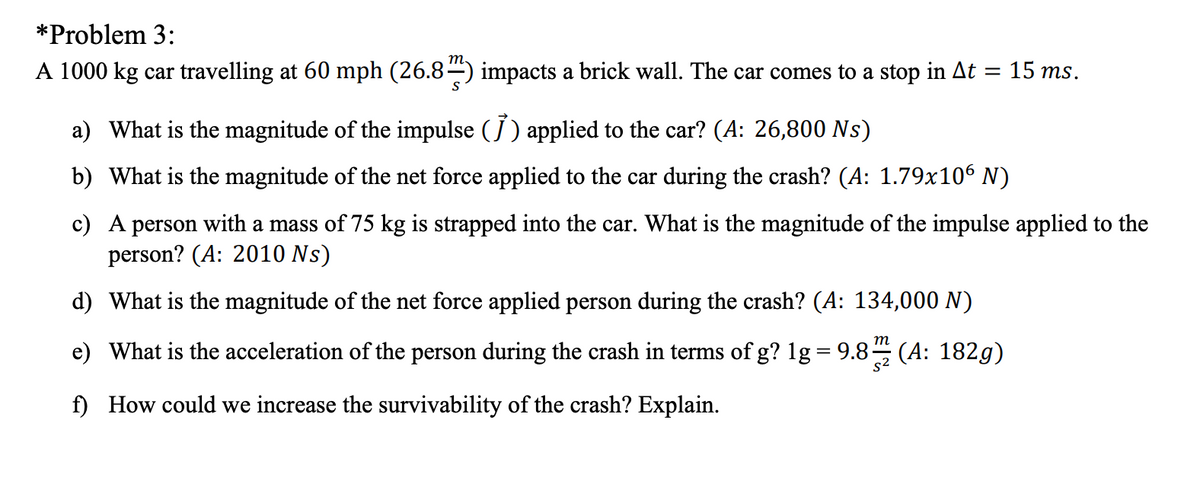*Problem 3: A 1000 kg car travelling at 60 mph (26.84) impacts a brick wall. The car comes to a stop in At = 15 ms. a) What is the magnitude of the impulse (J ) applied to the car? (A: 26,800 Ns) b) What is the magnitude of the net force applied to the car during the crash? (A: 1.79x106 N) c) A person with a mass of 75 kg is strapped into the car. What is the magnitude of the impulse applied to the person? (A: 2010 Ns) d) What is the magnitude of the net force applied person during the crash? (A: 134,000 N) e) What is the acceleration of the person during the crash in terms of g? 1g = 9.8 (A: 182g) f) How could we increase the survivability of the crash? Explain.
*Problem 3: A 1000 kg car travelling at 60 mph (26.84) impacts a brick wall. The car comes to a stop in At = 15 ms. a) What is the magnitude of the impulse (J ) applied to the car? (A: 26,800 Ns) b) What is the magnitude of the net force applied to the car during the crash? (A: 1.79x106 N) c) A person with a mass of 75 kg is strapped into the car. What is the magnitude of the impulse applied to the person? (A: 2010 Ns) d) What is the magnitude of the net force applied person during the crash? (A: 134,000 N) e) What is the acceleration of the person during the crash in terms of g? 1g = 9.8 (A: 182g) f) How could we increase the survivability of the crash? Explain.
Physics for Scientists and Engineers: Foundations and Connections
1st Edition
ISBN:9781133939146
Author:Katz, Debora M.
Publisher:Katz, Debora M.
Chapter11: Collisions
Section: Chapter Questions
Problem 13PQ: A crate of mass M is initially at rest on a level, frictionless table. A small block of mass m (m ...
Related questions
Question
100%
Can you please help with parts e and f?

Transcribed Image Text:*Problem 3:
A 1000 kg car travelling at 60 mph (26.84) impacts a brick wall. The car comes to a stop in At = 15 ms.
a) What is the magnitude of the impulse (J ) applied to the car? (A: 26,800 Ns)
b) What is the magnitude of the net force applied to the car during the crash? (A: 1.79x106 N)
c) A person with a mass of 75 kg is strapped into the car. What is the magnitude of the impulse applied to the
person? (A: 2010 Ns)
d) What is the magnitude of the net force applied person during the crash? (A: 134,000 N)
m
e) What is the acceleration of the person during the crash in terms of g? 1g = 9.8– (A: 182g)
f) How could we increase the survivability of the crash? Explain.
Expert Solution
This question has been solved!
Explore an expertly crafted, step-by-step solution for a thorough understanding of key concepts.
This is a popular solution!
Trending now
This is a popular solution!
Step by step
Solved in 2 steps with 2 images

Knowledge Booster
Learn more about
Need a deep-dive on the concept behind this application? Look no further. Learn more about this topic, physics and related others by exploring similar questions and additional content below.Recommended textbooks for you

Physics for Scientists and Engineers: Foundations…
Physics
ISBN:
9781133939146
Author:
Katz, Debora M.
Publisher:
Cengage Learning

College Physics
Physics
ISBN:
9781285737027
Author:
Raymond A. Serway, Chris Vuille
Publisher:
Cengage Learning

College Physics
Physics
ISBN:
9781938168000
Author:
Paul Peter Urone, Roger Hinrichs
Publisher:
OpenStax College

Physics for Scientists and Engineers: Foundations…
Physics
ISBN:
9781133939146
Author:
Katz, Debora M.
Publisher:
Cengage Learning

College Physics
Physics
ISBN:
9781285737027
Author:
Raymond A. Serway, Chris Vuille
Publisher:
Cengage Learning

College Physics
Physics
ISBN:
9781938168000
Author:
Paul Peter Urone, Roger Hinrichs
Publisher:
OpenStax College

Glencoe Physics: Principles and Problems, Student…
Physics
ISBN:
9780078807213
Author:
Paul W. Zitzewitz
Publisher:
Glencoe/McGraw-Hill

Principles of Physics: A Calculus-Based Text
Physics
ISBN:
9781133104261
Author:
Raymond A. Serway, John W. Jewett
Publisher:
Cengage Learning

Physics for Scientists and Engineers, Technology …
Physics
ISBN:
9781305116399
Author:
Raymond A. Serway, John W. Jewett
Publisher:
Cengage Learning